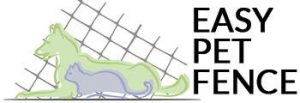By Jennifer Smith of EasyPetFence.com, a PPG corporate partner

Fencing allows pets to exercise, play and socialize with other animals and helps keep them safe © EasyPetFence.com
Dog trainers, animal shelters and pet owners alike choose to fence-in yards for several reasons. For one, pet fencing allows dogs and cats to exercise; play; and socialize with other animals. Fencing is convenient for pet owners that may not have nearby dog parks to visit, or much time to take their dogs on adventure hikes or lengthy jogs. And, pet fencing keeps domestic animals secure and protected against potential wildlife attacks.
While there are many types of pet fence on the market, not all kinds are considered humane. In fact, one of the most popular types of fence for dogs is wireless fencing; but it is also the most inhumane type of pet fence. It is so inhumane that countries such as England and Scotland have banned it from stores, thanks to proposals from local animal welfare organizations.
Wireless dog fences, also known as invisible dog fences, use shock collars and electric pulses to jolt a response in dogs. Many new dog owners choose to use shock collars as training tools; but what they do not realize is that they are instilling fear into their dogs by inadvertently harming their pets. If pets walk outside of the yard’s perimeter, the collar shocks the dog and stops them from moving about the landscape out of fear of being shocked again. Why would pet owners want to hurt domestic animals that they love strictly to teach them a lesson?
Pet owners that choose to stay clear of wireless dog fences often turn to chain-link fences; but these types of fence are not much better. While chain-link does not harm animals physically and psychologically, the fence is difficult to install without professional help; bulky; and let’s be honest, unsightly in yards. Chain-link fences corrode after years in the sun and can cheapen the look of houses over time. If pet owners are considering using chain-link in yards, they would do well to investigate other types of steel fence and do a cost comparison between other humane fence types.

The Steel Hex Web Fence from EasyPetFence.com is chew, dig and weather resistant, virtually invisible due to the PVC-coating and has a certified breaking load of 1000 lbs. © EasyPetFence.com
Other fence options that pet owners can consider using include plastic and metal fencing with PVC-coating. Plastic dog fences are used to secure small and calm dogs. This type of fence is not chew-proof, but it recommended for pets that will not pounce on, dig around, or challenge the strength of the system. Plastic fences are UV-stabilized to handle wear-and-tear from heat exposure and will last up to 20 years.
For large dogs with high amounts of energy, it is recommended to use steel fence with PVC-coating. While chain-link is made from galvanized steel, the PVC-coating on other types of steel fence, such as welded wire, will prevent chew marks from striking the steel core. This type of fence is stronger than plastic fence and will last up to 10 years longer.
Pet fencing is suggested for all types of animals to improve animal health and wellness. Some fence types are better than others for dogs, so, we recommend owners do the research to find the right fit for their dog.
About EasyPetFence.com
EasyPetFence.com cares about the outside safety and wellness of animals; which is why we only offer humane outdoor pet enclosures for dogs, cats and backyard chickens. Unlike chain-link fence that corrode, and wireless dog fence that shock dogs, an EasyPetFence.com fence will last up to 30 years in the field and look great in yards. EasyPetFence.com DIY pet fences are easy to install and do not require professional installation.

